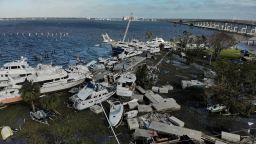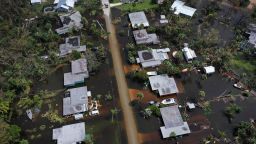Editor’s Note: Adam H. Sobel, a professor at Columbia University’s Lamont-Doherty Earth Observatory and Fu Foundation School of Engineering and Applied Science, is an atmospheric scientist who studies extreme events and the risks they pose to human society. Sobel is the host of the podcast “Deep Convection” and the author of “Storm Surge,” a book about Superstorm Sandy. Follow him on Twitter: @profadamsobel. The opinions expressed in this commentary are his own. View more opinion on CNN.
At the start of this Atlantic hurricane season, nerves were tense. With the Pacific under La Ni?a conditions for the third year in a row, and the memory of the record-breaking 2020 season fresh in our minds, the seasonal forecast was for an active 2022. Weather forecasters, scientists, insurance underwriters and emergency managers were braced for the possibility of a fresh burst of disastrous storms.

Then, almost nothing happened. We got from June well into September, the typical peak of hurricane season, with only a few weak storms, none doing any real damage. Then wham. Fiona took down Puerto Rico’s power grid on September 18 (almost five years to the day after Maria had all but destroyed it) and then much of Nova Scotia’s in Canada, and then Ian, after knocking out power to all of Cuba, made landfall in Florida as a dangerous Category 4, one of the most destructive storms ever to hit the continental US, and decimated a wide swath of the Sunshine State.
The storm may have caused as much as $47 billion in insured losses in the state, which could make it the costliest storm ever to hit Florida. The total loss will likely be much higher since most of the losses due to flooding – surely enormous, given the massive storm surges as well as river flooding that Ian produced – are not covered by private insurance. At least 76 people have died in the state because of the storm.
After each storm, reporters gather quotes from scientists like me for stories about how global warming is increasing the strength of hurricanes’ winds and rains. The stories – if they are any good – are more equivocal about whether there are more hurricanes than in the past.
What is going on? To what extent were these two recent disastrous storms, or any other particular ones, results of human influence on the climate? Here is my attempt to answer those questions, as briefly as possible while still doing justice to the uncertainties, as well as some insights from the latest, still rapidly evolving science.
Scientists are pretty confident that, on average, hurricane winds are getting stronger and rains heavier. These trends don’t explain a lot about any individual storm – most of what each one does is still determined by the random vagaries of weather – but in the aggregate, they increase the risk of major disasters such as Fiona and Ian. And sea-level rise makes coastal flooding from storm surge more destructive.
On the other hand, over most of the planet, there is no evidence that the total number of hurricanes each year is increasing. And as the planet warms further, we have no confidence in any prediction of what that number will do. Many models suggest the number will actually go down, but others say it will go up, and we don’t know which is right.
If the number of storms were to decrease fast enough, it could even compensate for the increases in hurricane intensity, so that the total risk would stay flat or decrease. That good-news scenario seems unlikely to me, but it can’t be ruled out.
On the other hand, the critical phrase in the above paragraph is “over most of the planet.” The North Atlantic, the basin that matters most by far to the United States in terms of hurricane risk, is the exception. In the North Atlantic, there has been a clear increase from the quiet 1970s and 1980s to a much more active period, on average, since the mid-’90s.
Some say the Atlantic increase is just the latest swing of a natural cycle. Before the lull in my youth, the 1950s and 1960s were very active, with many catastrophic US landfalls. (In the Northeast, for example, back-to-back hurricanes Carol and Edna struck in 1954, leading to the construction of storm surge barriers in Stamford, Connecticut, Providence, Rhode Island, and New Bedford, Massachusetts, all of which still operate today.)
Observations and climate models indicate that the Atlantic “thermohaline circulation” – the deep, slow overturning of the ocean involving sinking of cold Arctic water and gradual upwelling elsewhere – naturally fluctuates on multidecadal time scales, causing the North Atlantic to warm and cool, with associated heating up and cooling down of the hurricane seasons.
But this argument is not holding up so well lately. Recent research provides substantial evidence that the slowdown in the 1970s and 1980s was at least partly due to aerosol pollution from the US and Europe. Tiny aerosol particles cooled the North Atlantic by dimming the sunlight at the surface, and this cooling reduced hurricane activity.
Once these aerosols were cleaned up by legislation in the US in the 1950s to 1970s and then in Europe, the Atlantic was able to warm up again rapidly, now also charged by greenhouse gas increases.
This explanation is still debated, but I and many of my colleagues are now convinced by it. And to the extent it’s true, it means the likelihood of future quiet periods for Atlantic hurricanes is less than it would be in a world without human influence.
And new science darkens the prognosis for the Atlantic further. The last three years of La Ni?a conditions, when the eastern equatorial Pacific is cooler than average, are just part of a persistent trend in that direction over the last 50 years. Our climate models have failed to predict this, instead predicting that global warming should cause a trend toward more El Ni?o-like conditions.
This implies that the trend toward La Ni?a is an accident, a pileup of natural fluctuations, and should reverse at some point. If so, this would be good for the Atlantic since El Ni?o years, when the eastern equatorial Pacific is instead warmer than average, tend to see relatively few Atlantic hurricanes (but relatively more Pacific ones). La Ni?a years, on the other hand, usually have more Atlantic hurricanes (but fewer Pacific ones) – that’s why this season was forecast to be active.
But climate scientists are increasingly beginning to be concerned that climate models may be wrong about the recent trend toward La Nina being an accident, and thus likely to reverse – it may represent the true way the Pacific responds to greenhouse gas increases, implying that it will continue. If so, this would provide another reason for Atlantic hurricane activity to stay high or increase further.
I think the evidence that the models are wrong is compelling, and thus that, at least for the next few decades, there are two distinct reasons – aerosol cooling having been reduced over the Atlantic, and the Pacific response to warming being La Ni?a – rather than El Ni?o-like – why climate change favors more Atlantic hurricanes.
These climatic factors won’t explain that much about what happens with each individual season, let alone each single storm. Seasonal forecasts will still be only a little more often right than wrong. And the scientific uncertainties in long-term projections of hurricanes remain substantial. But as our understanding evolves, it is not going in a good direction for US hurricane risk.


